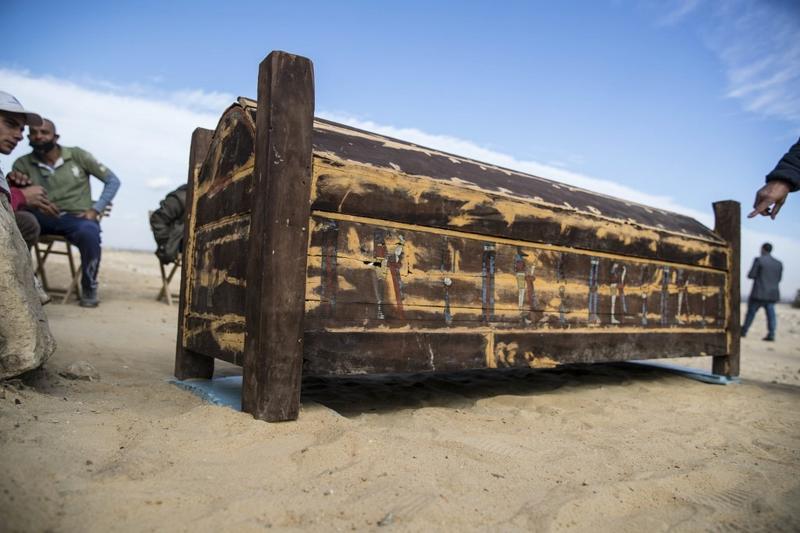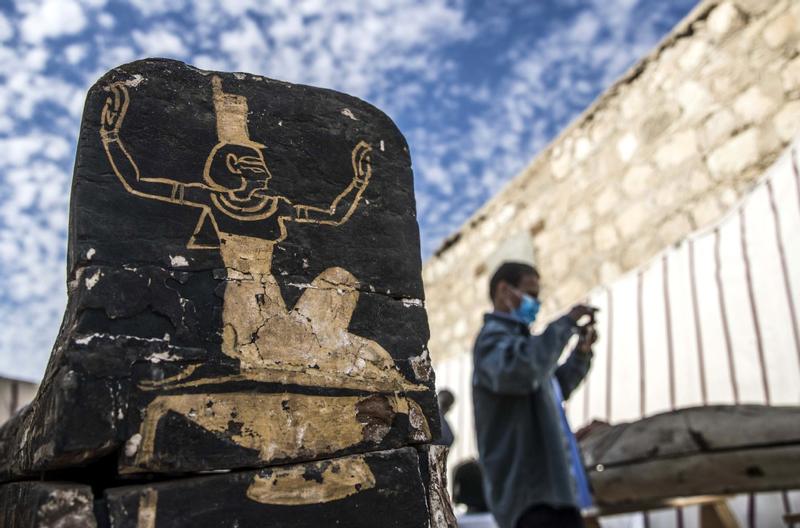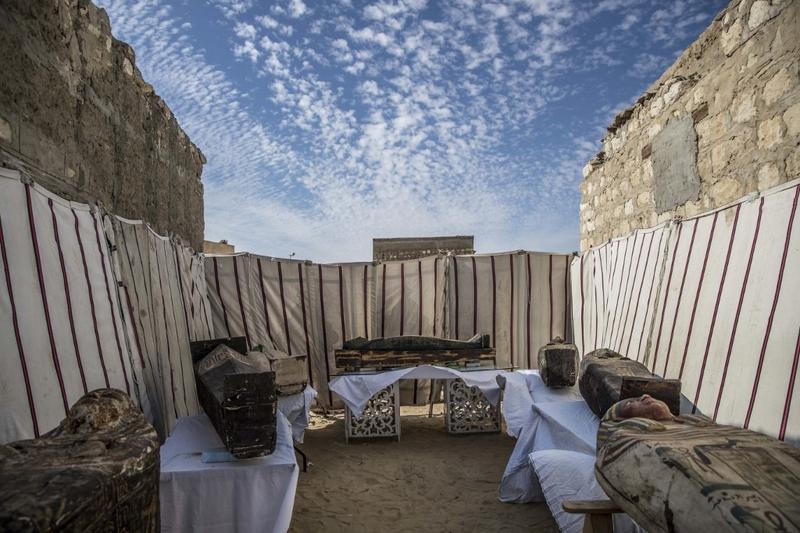 An adorned wooden sarcophagus is displayed during the official announcement of the discovery by an Egyptian archaeological mission of a new trove of treasures at Egypt's Saqqara necropolis south of Cairo, on Jan 17, 2021. (PHOTO / AFP)
An adorned wooden sarcophagus is displayed during the official announcement of the discovery by an Egyptian archaeological mission of a new trove of treasures at Egypt's Saqqara necropolis south of Cairo, on Jan 17, 2021. (PHOTO / AFP)
SAQQARA / CAIRO, Egypt-Egypt unveiled on Sunday ancient treasures found at the Saqqara archaeological site south of Cairo, including sarcophagi over 3,000 years old, a discovery that an expert says "rewrites history".
Saqqara is a vast necropolis of the ancient Egyptian capital of Memphis, a UNESCO World Heritage Site home to more than a dozen pyramids, ancient monasteries and animal burial sites.
The discovery introduces the name Queen Neit in ancient Egyptian history, as her husband King Teti was known before the discovery to have had only two wives: Iput I and Khuit II
The discovery introduces the name Queen Neit in ancient Egyptian history, as her husband King Teti was known before the discovery to have had only two wives: Iput I and Khuit II. Teti was the first pharaoh of the Sixth Dynasty, which ruled Egypt from 2323 BC till 2150 BC.
"Our archaeological mission discovered a pyramid in this place in 2010 but we didn't know the name of the owner. Only yesterday we discovered the funerary temple and found inscriptions showing that it belonged to a queen named Neit," Egyptian top archaeologist Zahi Hawass, head of the mission, said at the site.
READ MORE: A glimpse into history
"Queen Neit is a new name to be written in the history of the Old Kingdom of ancient Egypt," Hawass, also a former antiquities minister, said.
The site is located near the Pyramid of Teti, and Neit's funerary temple is opposite the remains of her pyramid that is also near the remains of a further two pyramids of King Teti's other two wives.
 Wooden coffins unearthed at a necropolis near Cairo are displayed at an unveiling of archaeological troves on Sunday. (KHALED DESOUKI / AFP)
Wooden coffins unearthed at a necropolis near Cairo are displayed at an unveiling of archaeological troves on Sunday. (KHALED DESOUKI / AFP)
"So far, we have unveiled only 30 percent of the antiquities buried in this place and 70 percent is still underground," said Hawass, noting that Egypt has more than 122 pyramids including 13 in Saqqara.
Hawass said these discoveries will "rewrite the history of this region", especially when it comes to the 18th and 19th dynasties of the New Kingdom (16th century BC to 11th century BC), during which King Teti was worshipped and the citizens at that time were buried around his pyramid.
The mission also found 22 burial shafts, with one of them alone containing 54 colorful coffins, besides the discovery of dozens of mummies, funerary figurines known as ushabtis, pots, stelae, miniatures of wooden boats with sailors onboard and a 5-meter tall papyrus. The items all dated to the New Kingdom nearly 3,000 years ago.
At a nearby corner in the site, hundreds of intact, broken and reassembled pots were displayed while specialists were working on reassembling more pieces
Joint mission
The joint mission is composed of the Zahi Hawass Center of Egyptology, which belongs to the Bibliotheca Alexandria, and the Supreme Council of Antiquities, or SCA, of the Egyptian Ministry of Tourism and Antiquities.
"Usually wooden coffins with mummies inside belong to the Old Kingdom, but finding wooden coffins with inscriptions from the New Kingdom is itself a new addition to this place, Saqqara," said SCA chief Mostafa Waziri near the burial shafts.
ALSO READ: Ancient murals restored with labors of love
At a nearby corner in the site, hundreds of intact, broken and reassembled pots were displayed while specialists were working on reassembling more pieces.
Nermeen Aba Yazeed, a creamologist with the SCA and a member of the mission, said that finding pieces of pots is the first step that leads to more information about the history of the place and the surrounding objects.
 Unearthed adorned wooden sarcophagi are displayed during the official announcement of the discovery by an Egyptian archaeological mission of a new trove of treasures at Egypt's Saqqara necropolis south of Cairo, on Jan 17, 2021. (Khaled DESOUKI / AFP)
Unearthed adorned wooden sarcophagi are displayed during the official announcement of the discovery by an Egyptian archaeological mission of a new trove of treasures at Egypt's Saqqara necropolis south of Cairo, on Jan 17, 2021. (Khaled DESOUKI / AFP)
"Through the unveiled pottery, we can find out the era to which the place belonged as well as the nature of the place whether it was for burial or dwelling because ancient house pots were different from those placed near coffins," Yazeed said.
She said the recently unveiled pots include some that give evidence of Egypt's ancient trade relations with Crete, Syria and Palestine.


